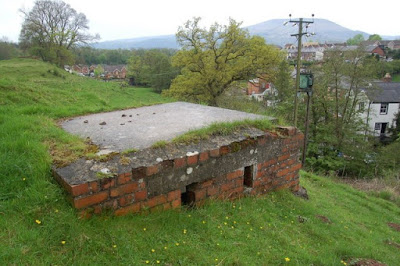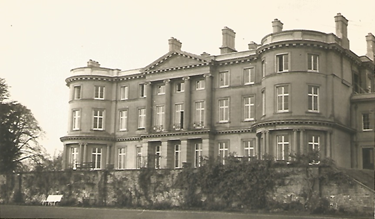Abergavenny and World War 11.
Abergavenny and World War 11
In 2001-2, a small group of
members of the Abergavenny Local History Society (ALHS) trained for in oral
history techniques and recorded as many people as they could find who had lived
in Abergavenny during WW2. They transcribed extracts from the recordings and
produced a book called ‘A Town Remembers: Memories of Wartime Abergavenny
1939 – 1945’. Copies exist in Abergavenny Library and Gwent Archives.
Fortunately, I bought one for myself, too, as it is now out-of-print!
Some of the present ALHS
Research group were trying to update this knowledge and managed to make three
more recordings recently. But memories of that time have faded. Marie was interviewed
by David and Barbara Powell and had the clearest memories. Marie was able to reminisce about her time at
school during the early part of the war. She then left to work in the telephone
exchange on Frogmore Street, a responsible job as it was easy to overhear
information when connecting people or checking if the line was in use. Very
excitingly, towards the end of war, she also went off to London and worked on an
Admiralty telephone exchange. That was something that would never have been
possible if it had not been for the war and the necessity of using women to do
unusual work for that time. She did not remember anything much about food
rationing, except to say that she thought that they ate quite well! She remembers cycling out to play tennis near
the Hardwick Inn and towards the end of the war, dancing with the American
troops before she went to London. And
she remembered the celebrations of VE Day in London.
One of the chapters in ‘A
Town Remembers’ contains the memories of those who were in the Home Guard.
On May 17th 1940, the Abergavenny Chronicle reported that a new Home
Front Army was to be formed by the War Office, originally called the Local
Defence Volunteers. (ALHS have access to the archives of the Abergavenny Chronicle.) Glyn Lewis’ father was one of the first to
volunteer and said that they were jokingly called ‘Look, Duck and Vanish boys’.
Viv Sadler’s father also volunteered and wore a long overcoat. This was shared
with another recruit who was much shorter and it hung around his ankles making
him look like a monk! Glyn Lewis’ uncle, Cliff Newton, had been in the 3rd
Mon Regiment in WW1, and he became a Captain in the LDV. Sergeant Ramsey who
had served in the Brecknock Battalion, and fought in both the Boer War and the
Home Service Battalion in WW1 had the difficult task of trying to train them to
be ‘first class irregulars’. Despite reports that they were training on rifles
and improvised hand-grenades, the weapons apparently included ‘thorn hedge
trimmings were of great use for the Home Guard’ as reported in the
Abergavenny Chronicle in January 1941. George Cobourne remembered training with
broom handles at first, but had a rifle when they were issued and trained in
the fields just past Nevill Hall hospital. He would often be on call for duty
for a 24 hour shift in addition to his work on the farm and had regular evening
shifts. David Edwards trained with the Home Guard until he was called up in
1943 and remembered some hair raising improvised weapons. John G. Williams
joined up in 1940 when he was still at King Henry VIII school. Later he worked
on a farm during the day and would be on duty all night once a week in a group
of three or four, patrolling in the evenings at other times.
Don
Davies remembers that they built a line like a railway line across Ross Road
into Abergavenny. To one side were some trucks filled with concrete. The idea
was that, if the German soldiers or tanks came, the trucks would be rolled
across the road so that the Home Guard in the pill boxes had time to mow them
down. In 2007, ALHS was contacted by someone (who preferred to remain anonymous
in case it got him into trouble with the farmer). He was concerned that the
pill boxes above Ross Road would be demolished for housing. He took me to see
them and I took photos and contacted CADW, who were, at that time asking for
WW2 remains to be recorded. CADW were able to contact the famer and survey the
site, so that they could be listed.
If
you walk along Ross Road from the town and look up behind the New Junction
Cottages by the river bridge, you will see the single pillbox overlooking the
Ross Road and the bridge over the Gavenny River.
A
further group of three nearer the town overlook Tredilion Road and Ross Road.
These covered the junction of the line between Hereford and Newport and the now
defunct line to Merthyr Tydfil.
The
view from the three pillboxes is across the north east side of Abergavenny and towards
the Sugar Loaf as well – an excellent vantage point. An air raid shelter on the
edge of the slope, near where the station used to be, is well protected by a
tree that has fallen across the entrance, but has the typical dogleg entrance
that I remember from my childhood, but smelled of sheep rather than wet wool,
urine and cigarette smoke. The shelter was provided for the workers at the
Junction Station. They are all on private land, so you will need to view them
from the adjoining Tredilion and Ross Roads.
Other
chapters in ‘A Town Remembers’ cover the Land Girls (have a look at the ALHS
Facebook page) as well as much else. Particularly, the story of the evacuees is
another that we would like to tell. ALHS have commissioned two commemorative
plaques for the evacuee story, one to go at Brecon Road Station (now Old
Station Surgery) and the other at Park Street School (now Abergavenny Community
Centre) where almost a whole Primary school from Birmingham arrived in 1939.
When we are able to put these up – we were just pipped at the post by the
lockdown – I will write about the background to these.
Gill
Wakley




